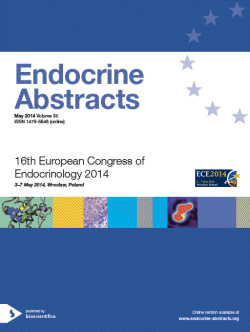Poster Presentations
Pituitary Basic (<emphasis role="italic">Generously supported by IPSEN</emphasis>)
ea0035p826 | Pituitary Basic (<emphasis role="italic">Generously supported by IPSEN</emphasis>) | ECE2014
Copeptin concentrations increase during glucagon stimulation test: possible role of copeptin in assessment of anterior pituitary function
Lewandowski Krzysztof , Lewinski Andrzej , Skowronska-Jozwiak Elzbieta , Stasiak Magdalena , Horzelski Wojciech , Brabant Georg
ea0035p827 | Pituitary Basic (<emphasis role="italic">Generously supported by IPSEN</emphasis>) | ECE2014
Effect of ubiquitin/proteosome inhibition on acth secretion by rat corticotropes
Sesta Antonella , Cassarino Maria Francesca , Cavagnini Francesco , Giraldi Francesca Pecori
ea0035p828 | Pituitary Basic (<emphasis role="italic">Generously supported by IPSEN</emphasis>) | ECE2014
Different expression of prolactin receptor gene in rat duodenum during physiological and medicamentous hyperprolactinemia
Radojkovic Danijela , Pesic Milica , Antic Slobodan , Radenkovic Sasa , Kostic Sonja , Curkovic Sanja , Vukelic Marija , Jevtovic-Stoimenov Tatjana
ea0035p829 | Pituitary Basic (<emphasis role="italic">Generously supported by IPSEN</emphasis>) | ECE2014
Prothymosin alpha and Ki-67 expression in pituitary adenomas
Golkowski Filip , Wierzbicka-Tutka Iga , Sokolowski Grzegorz , Baldys-Waligorska Agata , Adamek Dariusz
ea0035p830 | Pituitary Basic (<emphasis role="italic">Generously supported by IPSEN</emphasis>) | ECE2014
Dopamine receptor type 2 (dopamine receptor type 2) inhibits non-functioning human pituitary tumor-derived cell line HP75 migration through ROCK-mediated cofilin inactivation
Treppiedi Donatella , Peverelli Erika , Giardino Elena , Spada Anna , Mantovani Giovanna
ea0035p831 | Pituitary Basic (<emphasis role="italic">Generously supported by IPSEN</emphasis>) | ECE2014
Functional characterization of a new deletion in CDKN1B 5′-UTR region
Ruvo Mauro Di , Tagliati Federico , Gentilin Erica , Gagliano Teresa , Pellegata Natalia , Benfini Katiuscia , Uberti Ettore degli , Zatelli Maria Chiara
ea0035p832 | Pituitary Basic (<emphasis role="italic">Generously supported by IPSEN</emphasis>) | ECE2014
Correlation of coexpression of pituitary genes in QPCR and microarray study in pituitary adenomas
Zebracka-Gala Jadwiga , Larysz Dawid , Pfeifer Aleksandra , Rudnik Adam , Krajewska Jolanta , Hasse-Lazar Kornelia , Kowalska Malgorzata , Bazowski Piotr , Jarzab Barbara
ea0035p833 | Pituitary Basic (<emphasis role="italic">Generously supported by IPSEN</emphasis>) | ECE2014
Germline aryl hydrocarbon receptor interacting protein (AIP) gene mutations in patients with apparently sporadic pituitary macroadenomas (PMA): initial results
Skalniak Anna , Trofimiuk-Muldner Malgorzata , Pietkowski Jakub , Sokolowski Grzegorz , Hubalewska-Dydejczyk Alicja
ea0035p834 | Pituitary Basic (<emphasis role="italic">Generously supported by IPSEN</emphasis>) | ECE2014
Expression of peroxisome-proliferator activated receptor α in pituitary tumours
Rotondi Sandra , Modarelli Alessio , Rostomyan Lilya , Oliva Maria Antonietta , Esposito Vincenzo , Ventura Luca , Arcella Antonietta , Alesse Edoardo , Beckers Albert , Jaffrain-Rea Marielise
ea0035p835 | Pituitary Basic (<emphasis role="italic">Generously supported by IPSEN</emphasis>) | ECE2014
AIP expression in non-functioning pituitary adenomas is strongly associated with the gonadotroph phenotype but not with tumour aggressiveness
Rotondi Sandra , Oliva Maria Antonietta , Esposito Vincenzo , Ventura Luca , Giangaspero Felice , Alesse Edoardo , Jaffrain-Rea Marielise
ea0035p836 | Pituitary Basic (<emphasis role="italic">Generously supported by IPSEN</emphasis>) | ECE2014
Survivin expression in invasive pituitary gland adenomas with a diameter exceeding 20 mm
Waligorska-Stachura Joanna , Sawicka-Gutaj Nadia , Andrusiewicz Miroslaw , Ruchala Marek




